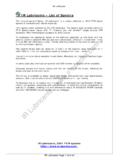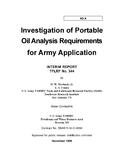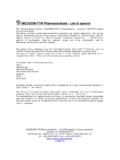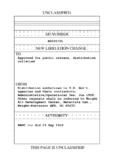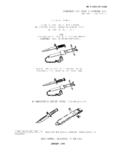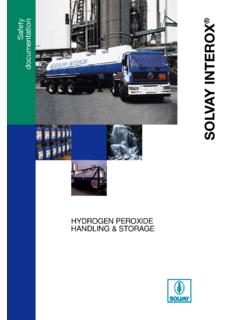Transcription of Estimating Vehicle Operating Costs - World Bank
1 World BANK TECHNICAL PAPER NUMBER 234 Estimating Vehicle Operating CostsRodrigo S. Archondo-Callao and Asif Faiz -qL- ,, X,-. -;.-I~~. -I ., ,,~~~~~~~~~~~~~~~~~~~~~~I-r~~~~ ./ I~~~~~~~~~~~~~~~~~~~RECENT World BANK TECHNICAL PAPERSNo. 180 Barghouti, Garbus, and Umali, editors, Trends in Agricullural Diversification: Regional PerspectivesNo. 181 Mining Unit, Industr,' and Energy Division, Strategyfor African MiningNo. 182 Land Resources Unit, Asia Technical Department, Stralegyfor Forest Sector Development in AsiaNo. 183 Najera, Liese, and Hammer, Malaria: New Patterns and Crosson and Anderson, Resources and Global Food Prospects: Supply and Demandfor Cereals to 2030No. 185 Frederiksen, Drought Planning anud Water Efficiency Implications in Water Resources ManagementNo. 186 Guislain, Divestiture of State Enterprises: An Overview of the Legal FrameworkNo. 187 De Geyndt, Zhao, and Liu, From Barefoot Doctor to Village Doctor in Rural Silverman, Public Sector Decentralization: Economic Policy and Sector Investment ProgramsNo.
2 189 Frederick, Balancing Water Demands with Supplies: The Role of Management in a World of IncreasingScarcityNo. 190 Macklin, Agricultural Extension in IndiaNo. 191 Frederiksen, Water Resources Institutions: Some Principles and PracticesNo. 192 McMillan, Painter, and Scudder, Settlement and Devklopment in the River Blindness Control ZoneNo. 193 Braatz, Conserving Biological Diversity: A Strategyfor Protected Areas in the Asia-Pacific RegionNo. 194 Saint, Universities in Africa: Strategiesfor Stabilization and RevitalizationNo. 195 Ochs and Bishay, Drainage GuidelinesNo. 196 Mabogunje, Perspective on Urban Land and Land Management Policies in Sub-Saharan AfricaNo. 197 Zymelman, editor, Assessing Engineering Education in Sub-Saharan AfricaNo. 198 Teerink and Nakashima, WaterAIlocation, Rights, and Pricing: Examplesfrom Japan and the UnitedSfatesNo. 199 Hussi, Murphy, Lindberg, and Brenneman, The Demlopment of Cooperatives and Other RuralOrganizations: The Role of the World McMillan, Nana, and Savadogo, Settlement and Development in the River Blindness Control Zone:Case Study Burkina Van Tuijl, Improving Water Use in Agriculture: Experinces in the Middle East and North AficaNo.
3 202 Vergara, The Materials Reolution: What Does It Mean for Developing Asia? Cleaver, A Strategy to Deop Agriculture in Sub-Saharan Africa and a Focusjfr the World Barghouti, Cromwell, and Pritchard, editors, Agricultural Technologiesfor Market-Led DevelopmentOpportunities in the 1990sNo. 205 Xie, Kuiffner, and Le Moigne, Using Water Efficiently: Technological OptionsNo. 206 The World Bank/FAO/UNIDO/Industry Fertilizer Working Group, World and Regional SupplYand Demand Balances for Nitrogen, Phosphate, and Potash, 19992-1997198No. 207 Narayan, Participatory Ewluatiow Toolsfor Managing Change in Water and Bindlish and Evenson, Evaluation ofthe Perbrmance of T&V Extension in KenyaNo. 209 Keith, Property Tar: A Practical Manualfor Anglophone Bradley and McNamara, editors, Living with Trees Policiesfor Forestry Management in Wiebers, Integrated Pest Management and Pesticide Regulation in Developing Frederiksen, Berkoff, and Barber, Water Resources Management in Asia, Volume J: Main Srivastava and Jaffee, Best Practicesfor Moving Seed Technology: New Approaches to Doing BusinessNo.
4 214 Bonfiglioli, Agro-pastoralism in Ckad as a Strategyfor Survival: An Essay on the Relationship betwuenAnthropology and StatisticsNo. 215 Umali, Irrigation-induced Salinity: A Growing Problmfor DEvlopment and the Carr, Improving Cash Crops in Africa Factors Influencing the Productivity of Cotton, Cofe, and TeaGrown by SmaihoUers(Ust continues on the inside back cover) World BANK TECHNICAL PAPER NUMBER 234 Estimating Vehicle Operating CostsRodrigo S. Archondo-Callao and Asif FaizThe World BankWashington, 0 1994 The International Bank for Reconstructionand Development/Tm World BAsN1818 H Street, , 20433, rights reservedManufactured in the United States of AmericaFirst printing January 1994 Technical Papers are published to communicate the results of the Bank's work to the development communitywith the least possible delay. The typescript of this paper therefore has not been prepared in accordance withthe procedures appropriate to formal printed texts, and the World Bank accepts no responsibility for sources cited in this paper may be informal documents that are not readily findings, interpretations, and conclusions expressed in this paper are entirely those of the author(s) andshould not be attributed in any manner to the World Bank, to its affiliated organizations, or to members of itsBoard of Executive Directors or the countries they represent The World Bank does not guarantee the accuracyof the data included in this publication and accepts no responsibility whatsoever for any consequence of theiruse.
5 Any maps that accompany the text have been prepared solely for the convenience of readers; thedesignations and presentation of material in them do not imply the expression of any opinion whatsoever onthe part of the World Bank, its affiliates, or its Board or member countries concerning the legal status of anycountry, territory, city, or area or of the authorities thereof or concerning the delimitation of its boundaries orits national material in this publication is copyrighted. Requests for permission to reproduce portions of it should besent to the Office of the Publisher at the address shown in the copyright notice above. The World Bankencourages dissemination of its work and will normally give permission promptly and, when the reproductionis for noncommercial purposes, without asking a fee. Permission to copy portions for classroom use is grantedthrough the Copyright Clearance Center, Inc.
6 , Suite 910, 222 Rosewood Drive, Danvers, Massachusetts 01923, cornplete backlist of publications from the World Bank is shown in the annual Index ofPubcons, whichcontains an alphabetical title list (with full ordering infonnation) and indexes of subjects, authors, andcountries and regions. The latest edition is available free of charge from the Distnbution Unit, Office of thePublisher, The World Band, 1818 H Street, , Washington, 20433, , or from Publications, TheWorld Bank, 66, avenue d'I6na, 75116 Paris, HDM-VOC program was written to assist in the operational work of the World Bank. The authors, theWorld Bank, the members of its Board of Executive Directors, and the countries they represent make norepresentations or warranty with respect to the HDM-VOC program other than as specified in the User LicenseAgreement The purchaser assumes all risk for the installation and use of, and results obtained from theprogram.
7 The authors and the World Bank shall not be liable for any error contained ir. the program or in thesupporting manual or documentation supplied with the program or for incidental or consequential damageresulting from furnishing, performance, or use of the program. Although every effort has been made to testHDM-VOC and ensure its accuracy, the World Bank is not in a position to provide user : 0253-7494 Rodrigo S. Archondo-Callao is a consultant to the Transport Division of the Transport, Water, and UrbanDevelopment Department Asif Faiz is division chief of the Infrastructure Division, Latin America and Department of Congress Cataloging-in-Publication DataArchondo-Callao, Rodrigo, 1959-Estinmating Vehicle Operating Costs / Rodrigo S. Archondo-Cafaoand Asif cm. -( World Bank technical paper, ISSN 0253-7494 ; 234)Includes 0-8213-2677-51. Motor vehicles- cost of operation-Data processing.
8 L Faiz,Asif. ll. Title. lll. Series: WorldBanktechnicalpaper ; 1993 93-37219 CUPC ontentsChapter 1 Ilnstallng HDM-VOC on Your Computer 1 SystcmRequircomets 1 Hardware 1 Software 1 Insalng and Running the Program 1 Floppy Disk System 1 Hard Disk Systcm 2 ProgramDiskBadcmp 3 Software Package Contents 3 Chapter2 Using the Program 5 The Modcl 5 The Main Screen 5 The Pages 6 The Input Data 6 The steps 7 The Resuts 8 The Defaul Valucs 8 Available Help 9 Chapter3 Main Menu Options 11 The Main Menu 11 Input Data for the Current Screen 12mModify the Data Displaycd 12 Save the Input Data 12 Load Input Data from Disk 13 Compute and Display the Results 13 Display the Input Data 13 Enter a Title for the Reports or Tables 14 Create Reports 14 The Reports 14 Destination 14 Create Tables 15 TheTables 15 The Requirement 16 Destination 16 Roughness Sensitivity Table 17 One Variable Sensitivity Table 17 One Variable Sensitivity Chart 18 Two Variables
9 Sensitvity Matrix 21 Vehicle Fleet Operating Costs Table 24 Vehicle Operating Costs Coedcients 26 List Files on Disk 2 Set all Input Variables to Zero 28 Quit the Program 28 Chapter 4 The HDM-VOC Relationships 29 The Steps 29 Vehicle Speed 30 The Steady-State Speed 30 VDRIVEu and VDRIVEd 34 VBRAKEu and VBRAXEd 36 VCURVE 37 VROUGH 38 VDESIR 40 Fuel Consumption 40 Lubricant Consumption 43 Tire Wear 44 Crew Time 47 Passenger Time 47 Cargo Holding 47ivMaintcnance Parts 47 Maintenance Labor 49 Dcpreciation 50 Vehicle Service Life (LIFE) 50 Vehicle Annual Utilization (AXM) 51 Interest 53 Overhead 54 Chapter SThe Input Data 55 Surface Type 55 Roughness 56 Vertical Profile 57 Horizontal Profile 60 Altitude of Terrain 62 Effective Number of Lanes 62 Vehicle Type 62 Tare Weight 63 Payload 64 Maximum Used Driving Power 65 Maimum Used Braking Power 66 Desired Speed 66 Aerodynamic Drag Coefficient 67 Projected Frontal Area 67 Calibrated Engine Speed 68 Energy-Efficiency Factor 68 Fuel Adjustment Factor 69 Tire Wear Information 69 Average Annual Utilizatio in Kilometers 70 Average Annual Utilization in Hours 70 Hourly Utilization Ratio 70 Average Service Life 70 Use Constant Service life?
10 71 Age of Vehicle in lrometers 71 Passengers per Vehicle 71 Unit Costs 72 New Vehicle Price 72 Fuel cost 72 Lubricants cost 72vNcw Tirc cost 72 Crcw Timc cost 72 Passenger Dclay Cosl 73 Maintenance Labor cost 73 Cargo Dclay cost 73 Annual Interest Ratc 73 Overhead per vehidce-km 73 Maintenance Parts Parametcrs 73 Maintenance Labor Paramctcrs 73 Lubricant Parameters 74 Vehicle Speed Parameters 74 Fuel Parameters 74 Additional Options 75 Rolling Resistance Coefricient 75 Vary Engine Speed for Cars 75 Specify Vehicle Speed 75 Index 77viForewordWhile the Costs of road construdion and maintenance consume a largeproportion of national budgets, the Costs borne by the road-using public forvehicle operation and depreciation are even greater. It is therefore impor-tant that road policies take account of total transportation Costs . This re-quires quantitative methods for predicting performance and Costs of bothroads and vehicles over large and diverse road networks, and under variousinvestment and management policies and order to develop such quantitative functions, the World Bank initiateda study in 1969 which later became a large-scale program of colaborative re-search with leading research institutions and road agencies in severalcountries.










